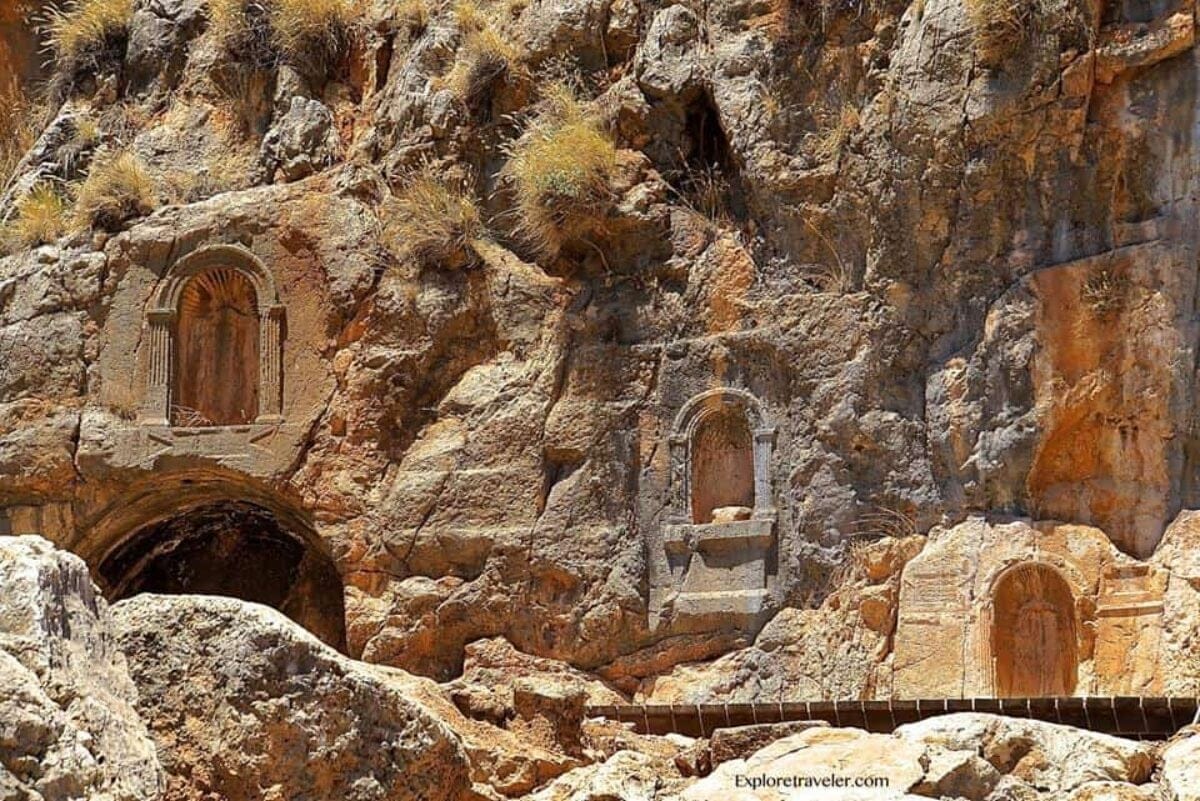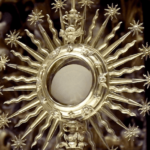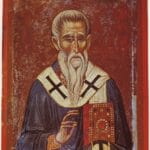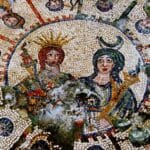Nestled at the foot of Mount Hermon, Caesarea Philippi stands as a testament to the rich tapestry of history, religion, and natural wonder. More than just an ancient city, Caesarea Philippi played a pivotal role in shaping the course of Christianity and the legacy of Jesus Christ. Its story, woven from threads of pagan cults, pivotal biblical events, and breathtaking landscapes, continues to captivate historians and spiritual seekers alike.
History of Caesarea Philippi
Long before its association with Christianity, Caesarea Philippi was a bustling center of pagan worship. The ancient Canaanites, who first inhabited the area, revered it as a sacred site dedicated to Baal. Later, the Greeks and Romans added their own cultural imprints, constructing temples and shrines that honored their deities, particularly Pan, the god of the wild. These structures stood as a testament to the city’s diverse religious landscape and its significance within the broader context of ancient beliefs.
Among Caesarea Philippi’s most notable features is the Cave of Pan, shrouded in mystery and steeped in myth. Believed to be a gateway to the underworld, this cavern played a central role in pagan rituals, some of which involved sacrifices and offerings to appease the gods. This eerie site, with its connection to ancient beliefs about the afterlife, adds a layer of mystique to Caesarea Philippi’s already rich history.
Archaeological excavations have unearthed a treasure trove of artifacts, including temples, shrines, and other remnants of the city’s pagan past. These discoveries offer tangible evidence of the religious practices and cultural influences that converged at Caesarea Philippi, providing invaluable insights into its vibrant history.
The Big Reveal: Jesus’s Declaration
It was against this backdrop of paganism that Jesus chose to reveal his true identity to his disciples, declaring himself the Messiah. This pivotal event, recorded in the Bible, transformed Caesarea Philippi from a center of ancient worship to a cornerstone of Christian history. The fact that Jesus chose this location, steeped in pagan beliefs and shadowed by the foreboding Cave of Pan, suggests a deliberate juxtaposition, highlighting the stark contrast between his message and the existing religious order.
The question of why Jesus chose Caesarea Philippi for such a momentous declaration continues to intrigue scholars. Some suggest that he intended to challenge the prevailing pagan beliefs, positioning his message as a beacon of light in a place seemingly shrouded in darkness. Others propose that the city’s natural beauty and its association with divine power, albeit pagan, might have resonated with the message he sought to convey.
What was Caesarea Philippi known for?
Caesarea Philippi’s allure extended beyond its religious significance. The city’s breathtaking natural beauty, with its lush forests, cascading waterfalls, and the imposing presence of Mount Hermon, undoubtedly contributed to its appeal as a sacred site. Situated near important trade routes, Caesarea Philippi became a cultural melting pot, where ideas and beliefs from across the ancient world converged.
To summarize, Caesarea Philippi was known for:
- A Hub of Pagan Worship: Shrines and temples dedicated to various gods, particularly Pan, dotted the city’s landscape.
- The Site of Jesus’s Revelation: The city is revered in Christian tradition as the place where Jesus revealed himself as the Messiah to his disciples, marking a pivotal moment in the development of Christianity.
- A Place of Natural Splendor: The city’s stunning natural scenery, with its forests, springs, and the captivating grotto, likely contributed to its religious significance.
Why is Caesarea Important in the Bible?
While Caesarea Philippi holds a significant place in Christian history, another city—Caesarea Maritima, often referred to simply as Caesarea—played a crucial role in the early spread of Christianity. Located on the Mediterranean coast, Caesarea served as a vital port city and a center of Roman governance. It was in this bustling metropolis that several key events in early Christian history unfolded.
One of the most notable events was the conversion of Cornelius, a Roman centurion. This event, described in the Book of Acts, marked a turning point in the early church, demonstrating that salvation was not limited to Jewish people but extended to Gentiles as well.
Caesarea also served as a base for Paul the Apostle’s ministry. The city witnessed several crucial moments in Paul’s life, including his imprisonment, his escape, and his numerous sermons. The importance of Caesarea in early Christianity is further underscored by its frequent mentions in the Book of Acts, which recounts the growth and spread of the early church.
Here’s a summary of Caesarea’s significance in the Bible:
| Importance | Description |
|---|---|
| Center for Spreading Christianity | Caesarea acted as a central hub, facilitating the spread of Christianity throughout the Roman Empire. |
| Conversion of Cornelius | This event was groundbreaking, demonstrating that Christianity was open to all people, regardless of their Jewish heritage. |
| Paul’s Ministry Base | Paul, a key figure in early Christianity, utilized Caesarea as his base of operations, and it was here that many significant events in his life took place. |
| Mentioned in Acts | The frequent mentions of Caesarea in the Book of Acts highlight its significance in the growth and development of the early church. |
While historical records and archaeological findings have revealed much about Caesarea, ongoing research continues to unearth new insights into the city’s past and its connection to the Bible. These discoveries serve as a reminder that our understanding of history is an evolving process.
What happened in the temple at Caesarea Philippi?
Adding to the complexity of Caesarea Philippi’s religious landscape was the presence of a grand temple built by Herod the Great, the powerful Roman-appointed king of Judea. This temple, dedicated to Caesar Augustus, served as a symbol of Herod’s allegiance to Rome and his desire to solidify his political power. The temple’s construction near the Cave of Pan, a site associated with pagan rituals and unsettling beliefs, adds another layer of intrigue to Caesarea Philippi’s story.
The juxtaposition of this grand Roman temple with the ancient pagan site speaks to the city’s role as a crossroads of cultures and beliefs. It was within this context, in a place where Roman power intersected with ancient pagan practices, that Jesus chose to reveal his true identity.
It is important to acknowledge that our understanding of the events at Caesarea Philippi is based on interpretations of historical and archaeological evidence. Research continues to shed light on the city’s complex past and the significance of the events that unfolded there.
What is the difference between Caesarea and Caesarea Philippi?
While they share part of a name, Caesarea and Caesarea Philippi were distinct cities with unique histories and characteristics. Think of it like this: two people might share the same last name but have vastly different personalities and life experiences.
Caesarea, situated on the Mediterranean coast, was a grand Roman city, built by Herod the Great to showcase the might and splendor of the Roman Empire. It boasted an impressive harbor, magnificent Roman architecture, a sophisticated aqueduct system, and even an amphitheater and hippodrome for entertainment. Caesarea was a bustling center of commerce and culture and played a crucial role in the early development of Christianity.
Caesarea Philippi, nestled at the foot of Mount Hermon, offered a different kind of appeal. It was a place of religious significance, home to various pagan temples and shrines. The city’s natural beauty, with its lush greenery and cascading waterfalls, undoubtedly contributed to its spiritual aura. Caesarea Philippi is perhaps best known as the site where Jesus asked his disciples the pivotal question, “Who do you say that I am?” (Matthew 16:15). This event solidified the city’s position as a significant location in Christian history.
In essence, Caesarea was a Roman powerhouse, a symbol of imperial might and a significant center for the early Christian church. Caesarea Philippi, on the other hand, was a spiritual hub, a place where pagan beliefs flourished and where Jesus chose to make a profound declaration about his identity.
While we have gleaned much information about these two cities from historical accounts and archaeological discoveries, there is still much to uncover. The ongoing exploration of these sites serves as a reminder that history is a tapestry woven from countless threads, and each new discovery helps us to better understand the intricacies of the past.
Why did Jesus choose Caesarea Philippi?
The question of why Jesus chose Caesarea Philippi, a city renowned for its pagan worship and association with the Roman Empire, to reveal his true identity has intrigued theologians and historians for centuries. Some scholars propose that Jesus intentionally chose this location because it represented a stark contrast to the Jewish faith. By revealing his divinity in a place steeped in pagan symbolism, Jesus may have been emphasizing the universal nature of his message and the power of his teachings to transcend cultural and religious boundaries.
Imagine the scene: Jesus, a Jewish teacher, stands with his disciples in the heart of Caesarea Philippi, a city adorned with temples and statues dedicated to pagan deities. It’s here, in this unlikely setting, that he asks his disciples the profound question: “Who do you say that I am?”. Peter, emboldened by the Holy Spirit, responds with a declaration that echoes through history: “You are the Christ, the Son of the Living God” (Matthew 16:16).
The location of this exchange amplifies its significance. By proclaiming his true identity in a place dedicated to other gods, Jesus challenged the prevailing religious order and asserted his authority over all powers and principalities. The “rock” upon which Jesus promised to build his church could be interpreted as a symbolic reference to Peter’s confession of faith, made even more powerful by its setting amidst pagan symbolism.
While the exact motivations behind Jesus’s choice of Caesarea Philippi remain a subject of debate, the city’s pagan associations and its location at a cultural crossroads provide compelling context for understanding the significance of this pivotal event.
Why is the conversation at Caesarea Philippi important?
The conversation that unfolded between Jesus and his disciples at Caesarea Philippi was a pivotal moment in the development of Christianity. It was here that Jesus challenged his followers to move beyond their understanding of him as a prophet or teacher and to embrace his true identity as the Messiah, the Son of God. Peter’s declaration of faith, “You are the Christ, the Son of the Living God,” marked a turning point, signifying the disciples’ growing understanding of Jesus’s divine nature and his mission.
This exchange transcended a mere conversation; it was a declaration of purpose, a laying of the foundation for the Christian church. Jesus’s response to Peter’s proclamation, “On this rock, I will build my church,” underscores the significance of this moment. The imagery of a church built on a rock speaks to the strength, endurance, and unwavering foundation of the Christian faith.
The fact that this conversation occurred in Caesarea Philippi, a city steeped in paganism and Roman influence, adds another layer of meaning. By choosing this location, Jesus may have been symbolically challenging the prevailing religious and political structures of the time, asserting that his kingdom would be established on a foundation of faith, not on human constructs or worldly power.
What did they sacrifice at Caesarea Philippi?
Caesarea Philippi, as a center of pagan worship, witnessed various forms of sacrifice, each reflecting the beliefs and practices of the cultures that converged there. The Greeks, who revered Pan, the god of the wild, likely made offerings to ensure fertility and protection for their flocks and crops. The Romans, who honored Bacchus, the god of wine and revelry, may have made sacrifices to seek blessings for their vineyards and to ensure a bountiful harvest.
However, the most disturbing aspect of Caesarea Philippi’s sacrificial past is the evidence of child sacrifice, a practice associated with the Canaanites who inhabited the region before the Greeks and Romans. While the specifics of these rituals remain shrouded in mystery, archaeological findings suggest that infants were sometimes offered as sacrifices to appease the gods or to ensure the community’s well-being.
The Cave of Pan, believed to be a gateway to the underworld, likely served as a central location for these sacrifices. The discovery of human remains, including those of children, within the cave supports the accounts of these rituals, providing a chilling glimpse into the beliefs and practices of the ancient world.
While it is difficult to fully comprehend the motivations behind these ancient practices, the evidence of sacrifice at Caesarea Philippi serves as a reminder of the diverse and sometimes brutal nature of ancient religions.
What is another name for Caesarea Philippi?
Like many ancient cities, Caesarea Philippi underwent several name changes throughout its history, each reflecting the influence of different cultures and rulers. Before the arrival of the Greeks, the city was known as Baal-gad, a name that reflects its early association with Canaanite worship. The Greeks, drawn to the site’s natural beauty and its sanctuary dedicated to Pan, renamed it Paneas.
When Philip the Tetrarch, the Roman ruler of the region, expanded and fortified the city, he renamed it Caesarea Philippi in honor of himself and the Roman emperor, Tiberius Caesar. Later, during the reign of Emperor Nero, the city was briefly known as Neronias.
The fact that Caesarea Philippi bore so many names reflects its strategic importance and its position at a crossroads of cultures. Each name provides a glimpse into a different chapter of the city’s history, reminding us that places, like people, can accumulate stories and identities over time.
What was the church in Philippi known for?
Moving from Caesarea Philippi, we encounter the church in Philippi, a vibrant community that emerged in the first century. What distinguished the Philippian church from other early Christian communities was its diverse makeup and its unwavering spirit. Unlike many early churches, which consisted primarily of Jewish Christians, the church in Philippi was composed largely of Gentiles—people who did not have a Jewish background.
This diversity contributed to the church’s unique character. Women played active roles in the Philippian church, with individuals like Lydia, a prominent businesswoman, mentioned as key figures in its establishment and growth. The church in Philippi was renowned for its generosity and unwavering support of Paul the Apostle’s ministry, even in the face of hardship. The Philippians’ unwavering faith and their commitment to supporting one another serve as powerful examples of Christian unity and perseverance.
Why was Caesarea abandoned?
The once-bustling city of Caesarea, a symbol of Roman power and engineering, eventually succumbed to the forces of history. The city’s decline likely began in the 7th century following the Muslim conquest of the region. As Caesarea lost its strategic importance and its status as a provincial capital, its population dwindled, and its grand structures fell into disrepair.
While the Crusaders attempted to revive Caesarea during their reign in the 11th century, the city never fully regained its former glory. By the 13th century, under Mamluk rule, Caesarea had faded into obscurity, its harbor silted up and its once-grand buildings reduced to ruins.
The abandonment of Caesarea, while a testament to the transient nature of power and prosperity, paved the way for large-scale archaeological excavations. These excavations have unearthed a wealth of information about the city’s Roman past, revealing the splendor of its architecture, the sophistication of its infrastructure, and the details of daily life in a Roman port city.
While the exact reasons for Caesarea’s abandonment might never be fully known, the city’s ruins stand as a poignant reminder of the ebb and flow of history and the enduring power of the past to captivate our imaginations.
Discover the captivating history of Orpheus BG3 and the enigmatic history of Prince Orpheus BG3 in an enchanting narrative that will transport you to a realm of myth and intrigue.
- China II Review: Delicious Food & Speedy Service - April 17, 2025
- Understand Virginia’s Flag: History & Debate - April 17, 2025
- Explore Long Island’s Map: Unique Regions & Insights - April 17, 2025
















